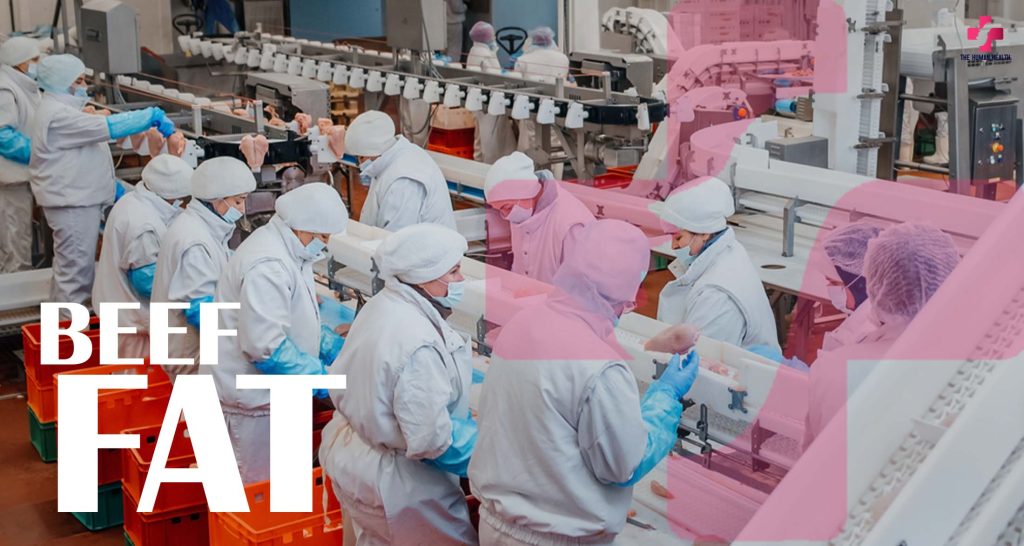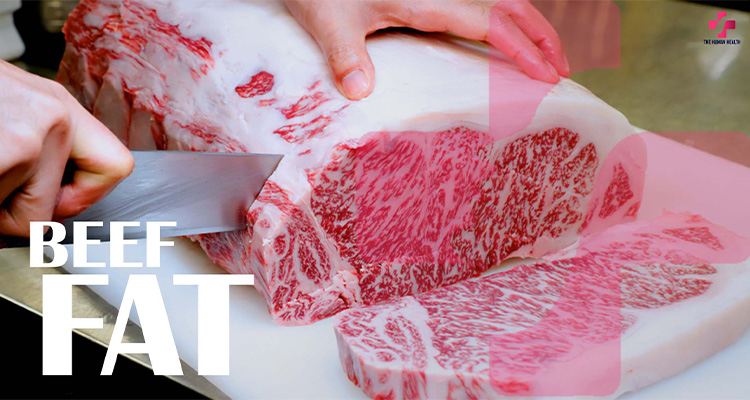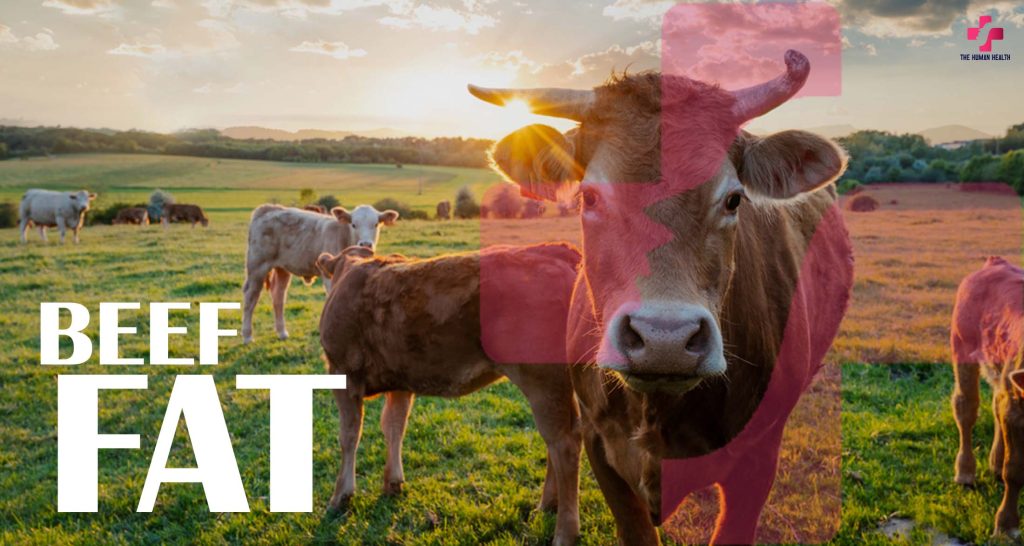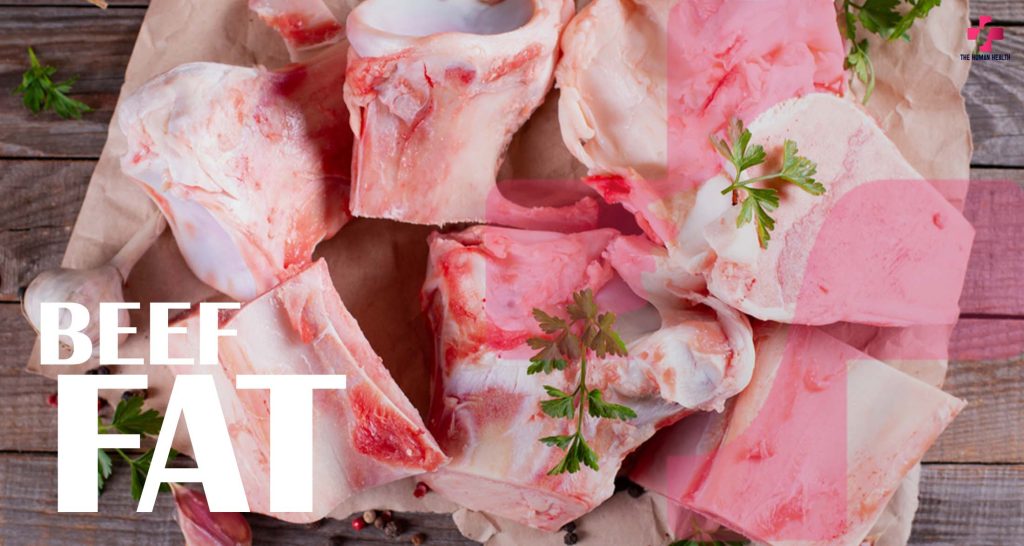What is Beef Fat Called?
Beef fat comes from cows. It has different names based on how it is used. The most common name is tallow, but there are others too
Tallow: Melted Beef Fat
Tallow is beef fat that has been melted and cleaned. It turns solid when cool. People have used tallow for cooking, making soap, and even making candles. Today, it is still used in food, skincare, and fuel.
Suet: Raw Beef Fat
Before beef fat is turned into tallow, it is called suet. Suet is the firm, white fat near a cow’s kidneys. It melts at high heat and is used in old-fashioned recipes like puddings, dumplings, and pies. Suet makes food rich and flaky.
Marrow Fat: Fat Inside Bones
Marrow fat is inside beef bones, especially the leg bones. It is soft and buttery. Chefs love using it in fancy dishes. People roast it, spread it on toast, or mix it into soups for extra flavor.
Leaf Fat: The Best Suet
A special type of suet is leaf fat. It comes from the kidneys and is the purest form of beef fat. People use it to make tallow or in fine baking.
Beef Drippings: Fat from Cooking
When beef is roasted, some fat melts. This is called beef drippings. It is tasty and great for frying, making gravy, or roasting veggies. Long ago, people even spread it on bread.
How People Use Beef Fat
Beef fat has many uses, such as:
Cooking: Tallow and suet are great for frying and baking.
Skincare: Some soaps and creams use beef fat for moisture.
Candles: Before wax, people made candles from tallow.
Fuel and Industry: Tallow is used in fuel and to oil machines.
Animal Food: Some farm animals eat food with beef fat for energy.
Conclusion
Beef fat has many names, depending on how it is prepared. Tallow is melted fat, while suet is raw fat. Other types include leaf fat, marrow fat, and drippings. Even today, beef fat is useful in cooking and other industries.
Is Beef Fat a Healthy Fat?
Many people wonder if beef fat is healthy. Some say it’s good for you, while others worry about its high fat content. Let’s take a look at what beef fat is, how it affects health, and how it compares to other fats.
What’s in Beef Fat?
Beef fat is made up of three main fats:
50% saturated fat
42% monounsaturated fat
4% polyunsaturated fat
Saturated fat has been linked to high cholesterol and heart disease. But new research shows that it might not be as bad as once thought. The monounsaturated fat in beef fat is good for your heart. It’s also found in olive oil and avocados.
Beef fat also has vitamins A, D, E, and K. It contains CLA, a fat that may help reduce inflammation and improve metabolism.
Health Effects of Beef Fat
Beef fat affects health in different ways. It depends on things like metabolism, diet, and the source of the beef. Here are some key points:
Heart Health – Saturated fats have been blamed for heart disease. But some studies show that fat from whole foods, like grass-fed beef, may not harm the heart the way processed fats do.
Inflammation and Metabolism – Grass-fed beef fat has more omega-3s and CLA. These can reduce inflammation and help metabolism. Grain-fed beef has less omega-3 and may not have the same benefits.
Weight Management – Eating fat, like beef fat, can help you feel full and eat less. High-fat, low-carb diets like keto may help with weight loss.
Cooking with Beef Fat – Beef fat is good for cooking because it stays stable at high heat. It doesn’t break down like vegetable oils, which can form harmful compounds.
How Beef Fat Compares to Other Fats
Here’s how beef fat compares to other fats:
Better than vegetable oils – Oils like soybean, canola, and corn oil have too many omega-6 fats, which may cause inflammation. Beef fat, especially from grass-fed cows, has a better balance of omega-6 and omega-3 fats.
Similar to coconut oil and butter – Beef fat is like these fats because it’s high in saturated fat. But beef fat also has CLA and vitamins. Coconut oil has MCTs, which help metabolism.
Not as good as olive oil – Olive oil is a very healthy fat. It has antioxidants and monounsaturated fats. Still, beef fat can be healthy in moderation.
Conclusion
Beef fat can be a healthy fat, especially if it comes from grass-fed cows. It has more nutrients than grain-fed beef fat. Using beef fat in moderation, especially for cooking, can be a healthier choice than processed oils. The key is to use a variety of healthy fats in your diet.
Is Beef Fat Good For Skin?
Beef fat, also called tallow, has been used for many things like cooking, skincare, and candles for years. Recently, it has gained attention in skincare for its good effects. But is beef fat good for the skin? Let’s take a look at what tallow is, how it helps, and what to keep in mind when using it.
What is Beef Fat (Tallow)?
Beef fat comes from cows. It’s mostly taken from the stomach and kidneys. The fat is melted, then cooled, turning solid. Tallow is full of healthy fats, like omega-3 and omega-6 fatty acids. It also has vitamins A, D, E, and K, which are great for your skin. These things make tallow good for skincare.
Moisturizing Benefits
Tallow is great for keeping your skin soft and moisturized. The fats in beef fat hold moisture and help keep the skin healthy. This makes it useful for dry or cracked skin because it can help keep your skin hydrated.
Tallow is like the natural oils our skin makes. This means it’s easy to absorb and won’t clog pores. Unlike many moisturizers that leave your skin feeling greasy, tallow soaks in well and keeps your skin soft.
Anti-Inflammatory Properties
Tallow has omega-3 and omega-6 fats, which are important for your skin. Omega-3 helps calm skin irritation and reduce redness. If you have skin problems like eczema or rosacea, tallow may help with the swelling and irritation.
Vitamin E in tallow is a strong antioxidant that protects your skin from damage. It can help reduce signs of aging, like wrinkles and fine lines. This makes tallow a great natural option for skincare.
Healing and Regeneration
Tallow can help your skin heal. The fats and vitamins in tallow help your skin grow back and heal faster. It’s great for scars, cuts, and burns. Vitamin A in tallow helps your skin repair itself and make new skin cells, which helps your skin heal.
Considerations and Precautions
Tallow may not be right for everyone. If you have sensitive skin or acne, be careful with tallow. The fat in tallow can clog pores and cause pimples for some people. If you’re not sure, try it on a small patch of skin first.
Make sure you use high-quality tallow. Tallow from grass-fed cows is usually better because it has more nutrients and fewer chemicals that could hurt your skin.
Conclusion
Beef fat, or tallow, is good for moisturizing and healing your skin. It’s full of healthy fats, vitamins, and antioxidants. It’s especially helpful for dry or irritated skin. However, if you have sensitive or acne-prone skin, use tallow carefully. Always test it on a small area first and choose good quality tallow for the best results.
Is Beef Fat Bad Cholesterol?
Beef fat is often discussed because of its effect on cholesterol and health. Let’s look at whether beef fat raises bad cholesterol and how it fits into a healthy diet.
Types of Fat in Beef
Beef fat has two types of fat: saturated and unsaturated. Saturated fat is solid at room temperature. It is found in beef and other animal products. Unsaturated fat is liquid at room temperature and is found in plant oils and fish. Beef also has a small amount of trans fats, but they are less important than the saturated fat.
Saturated fats are linked to higher cholesterol levels. When we eat them, our bodies make more LDL (bad) cholesterol. This can cause plaque to form in the arteries, which increases the risk of heart disease. Eating too much saturated fat can raise LDL levels and lead to heart problems.
LDL and HDL Cholesterol
Cholesterol is important for the body to build cells and make hormones. But it is important to have the right balance of LDL (bad) cholesterol and HDL (good) cholesterol. HDL helps remove extra cholesterol from the blood. This lowers the chance of plaque forming in the arteries. Too much LDL can cause arteries to become narrow and hard. This increases the risk of heart disease and stroke.
The concern with beef fat comes from its high amount of saturated fat. But studies show that the link between saturated fat and heart disease may not be as strong as once thought. Other factors, like diet, lifestyle, and genetics, also affect cholesterol levels and heart health.
Beef Fat and Diet
Eating beef fat in moderation is key. Eating beef fat once in a while may not affect cholesterol much. But eating a lot of beef fat, especially from fatty or processed cuts, can raise LDL cholesterol over time. Balance beef fat with healthier fats like those found in nuts, seeds, avocados, and fatty fish. These fats can help improve cholesterol and provide important nutrients.
If you care about cholesterol and heart health, limit fatty cuts like ribeye or T-bone. Choose leaner cuts, like sirloin or round. Grass-fed beef is a better choice, as it has more omega-3 fats, which are good for heart health.
Conclusion
Beef fat has saturated fat, which can raise LDL cholesterol if eaten too much. But the effect of beef fat on cholesterol depends on things like how much you eat, how often, and your overall diet. Eating beef in moderation, especially lean cuts and grass-fed beef, can be part of a healthy diet. But balance it with other healthy fats to keep your cholesterol in check and lower your risk of heart disease.
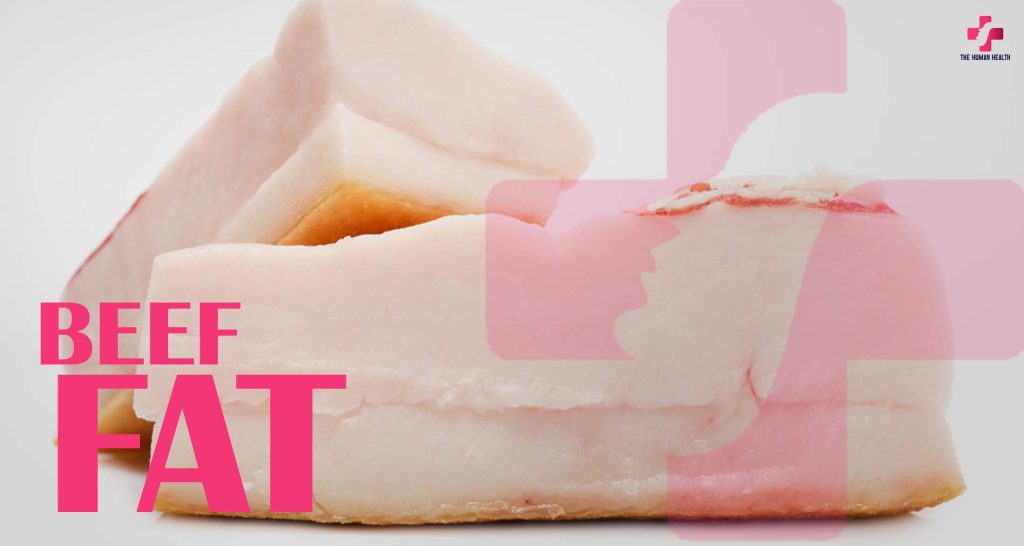
Why Does Beef Fat Taste Good?
Beef fat has been a favorite in cooking for a long time. People love it for its rich taste in bacon, steaks, and other dishes. But why does beef fat taste so good? Let’s take a look.
- Fat Makes Flavors Better
One reason beef fat tastes so good is that it helps bring out flavors. Fat carries flavors well, especially those that make food taste rich and savory. When beef cooks, the fat melts and lets out these flavors. As it melts, it coats the meat, making every bite flavorful. - Umami Taste
Beef fat has lots of umami. This is a savory taste that makes food taste meaty. Beef contains glutamates, which are released when fat melts. These glutamates mix with other flavors in the beef, making it taste even better. This is why beef fat goes well with things like mushrooms, onions, and garlic. - Texture and Feel
Beef fat also changes how the meat feels when you eat it. The fat melts and makes the meat juicy and tender. This gives the beef a smooth, creamy feel. The outer crust of the beef is crispy, while the inside stays soft and juicy. - Browning and Sweetness
When beef fat cooks, it browns in a process called the Maillard reaction. This creates deep, savory flavors. As the fat melts, it also caramelizes, making the beef taste rich and nutty. This happens when beef is grilled or roasted at high temperatures, making the outside crispy. - Fullness and Satisfaction
Beef fat makes you feel full and satisfied. It helps release hormones that tell your body you’re done eating. This makes beef fat feel indulgent and comforting. It also helps slow digestion, so meals feel longer-lasting. - Memories and Feelings
Beef fat is tied to memories of good times. It reminds people of family meals and special occasions. The smell of beef fat cooking can bring back warm memories. These emotions make the fat taste even better.
Conclusion
Beef fat tastes good for many reasons. It brings out flavors, has a rich umami taste, changes texture, caramelizes well, makes us feel full, and connects to happy memories. When cooked right, beef fat adds a deep, satisfying flavor. Whether it’s a juicy steak or crispy roast beef, beef fat makes the dish even better.
Why is Beef Fat Yellow?
Beef. fat is yellow because of certain compounds. These compounds depend on the cow’s diet, how the fat reacts to heat, and how light affects it. Let’s find out why beef. fat is yellow.
- Carotenoids in the Diet
Carotenoids make beef. fat yellow. These natural pigments are in plants like grass and vegetables. When cows eat grass, they store carotenoids in their fat. Carotenoids, like beta-carotene, make carrots and leafy greens look orange or yellow.
Cows that eat more grass have more carotenoids, making their fat more yellow. Cows that eat grains, especially in feedlots, have less carotenoids, so their fat is lighter.
- Fat Types
Beef. fat has different kinds of fats. Some fats are saturated, some are monounsaturated, and others are polyunsaturated. Carotenoids are the main factor that makes the fat yellow.
Fat near the cow’s belly has more carotenoids and looks more yellow. Marbled fat inside the muscle is spread out, so it looks less yellow.
- Storage of Vitamins
Carotenoids are fat-soluble, meaning they dissolve in fat. Beef. fat stores vitamins like vitamin A, which helps with vision and immunity. Cows on pasture, eating grass, store more vitamins in their fat, making it more yellow.
- Grass-Fed vs. Grain-Fed Beef
Grass-fed cows have more carotenoids in their fat, so their fat is yellow. Grain-fed cows have less carotenoids, so their fat is lighter. Grass-fed beef also has more nutrients, like omega-3 fatty acids, because of the grass diet.
- Oxidation and Light
The yellow color of beef. fat can change over time. When exposed to air, carotenoids break down, and the fat turns lighter. Cooking beef fat at high temperatures also changes its color and texture.
Conclusion
Beef. fat is yellow because of carotenoids, which come from the cow’s diet. Cows that eat more grass have yellower fat because they have more carotenoids. Whether grass-fed or grain-fed, the fat color tells us about the cow’s diet and the quality of the meat.
How To Use Beef Fat?
Beef fat, also called tallow, is very useful. It can be used in cooking, baking, and even for other things. It comes from the fat around the muscles and organs of a cow. Tallow can handle high heat, so it’s great for frying and sautéing. Here are some easy ways to use it:
- Cooking and Frying
Beef fat is great for cooking foods at high heat. It works well for frying, sautéing, and roasting. You can fry potatoes, chicken, or beef with it. Tallow gives your food a rich flavor. Just melt it in a pan and cook your food as usual. - Roasting Vegetables
Roasting vegetables in beef fat makes them taste great. The fat makes the outside crispy and keeps the inside soft. Melt some beef. fat, toss your vegetables (like potatoes or carrots) in it, and roast them. They will have a savory, delicious taste. - Gravy and Sauces
You can use beef fat for gravies and sauces. It adds a rich flavor. To make gravy, heat the fat until it melts. Then cook onions or garlic in it. Add flour to make a thick paste, then slowly add broth. Let it thicken to make smooth gravy. - Baking
Beef fat can replace butter or oil in baking, especially for savory foods. It works in pie crusts, biscuits, and bread. Using beef fat makes pies and pastries flaky. Just use the same amount of beef. fat as you would butter. It’s perfect for meat pies or empanadas. - Making Beef Jerky
Bef fat keeps jerky moist and tasty. You can add small amounts of fat to lean meat before drying or smoking it. The fat helps the jerky stay tender and adds great flavor. - Soap Making
Beef fat can also be used for soap. Tallow helps make a hard, long-lasting bar with smooth lather. Many people like tallow soap because it’s good for the skin. - Skin Care
Beef fat is good for your skin. It has fatty acids that help moisturize and nourish it. You can use it in balms, lotions, and lip balms. Just melt the tallow and mix it with oils or beeswax. - Candle Making
Beef fat can be used to make candles. It burns slowly and creates a long-lasting flame. You can make candles by melting tallow, adding a wick, and pouring it into a mold. The candles burn clean and smell nice.
Conclusion
Beef fat, or tallow, is useful in many ways. It works in cooking, baking, soap making, and skincare. Adding it to your daily routine gives you many benefits.
Does Beef Fat Have a Smell?
Beef fat has a strong smell that changes depending on how it’s made and used. It often smells rich, savory, and greasy. Some people describe it as meaty or oily. The smell can change based on how sensitive someone is to it and how it’s being used.
Raw beef fat has a mild smell. It may be a little metallic or gamey, but it’s not bad. Fresh beef. fat should smell clean, like butter, with a slight beefy scent. If it’s been stored too long or not trimmed, it can smell stronger. If left in the fridge or at room temperature too long, it can go bad. Bad beef. fat smells sour and musty, and it’s no longer safe to eat.
When beef fat is cooked or melted, it smells stronger. The process of rendering it makes the smell richer. It fills the kitchen with a savory, greasy scent. This is especially true if you’re using it to cook. Beef fat, also called tallow, is good for frying because it has a high smoke point. While cooking, the smell is full of deep flavor. It’s even better when used for foods like steak or potatoes.
Beef fat can also smell different depending on the cow’s diet. Cows that eat grass often have fat that smells earthy or herbal. Cows that eat grain may have fat with a milder, slightly sweet scent. What the cow eats changes the fat’s scent, and so does the breed and age of the cow.
Some people love the smell of beef fat because it adds flavor to food. But others may find it too strong, especially if they’re not used to cooking with animal fats. In some homes, the smell can linger and be hard to get rid of. To reduce the smell, you can open windows or use an exhaust fan. You can also add herbs or spices to the fat while cooking to help cover the smell.
In conclusion, beef fat has a strong smell that depends on how fresh it is, how it’s prepared, and what the cow ate. It can smell savory when fresh and cooked, but it can turn bad if not stored well. Some people like the smell for its rich flavor, but others may not.
What Are The Disadvantages of Beef Fat?
Beef fat is a type of animal fat. It can make food taste good and give you some nutrients, but it can also cause harm if you eat too much. Here’s why you should be careful with bef fat:
High in Bad Fats
Beef fat has a lot of bad fats called saturated fats. Eating too much can raise your “bad” cholesterol, which can clog your arteries. This makes heart problems more likely. Too much fat can also lower your “good” cholesterol, which helps clear out the bad stuff.
Weight Gain
Beef fat is full of calories. Eating too much can lead to weight gain. Being overweight raises your risk for diabetes, high blood pressure, and cancer. If you eat too many high-fat foods like bef fat, it can be hard to keep a healthy weight.
Bad for Your Stomach
Eating too much fat can upset your stomach. It can mess with the good bacteria in your gut and cause problems like bloating or indigestion. If you already have stomach issues, like acid reflux, beef fat can make things worse.
Serious Health Problems
If you eat too much beef. fat over time, it can cause health problems like heart disease and cancer. The fat can clog your arteries, which can lead to heart attacks. Too much red meat and fat can also raise your risk for colon cancer.
Hurts the Environment
Beef. fat is bad for the planet. The meat industry uses a lot of natural resources and creates pollution. This can make climate change worse. Eating beef. fat contributes to the damage.
Inflammation
Eating too many saturated fats can make your body inflamed. Chronic inflammation is linked to diseases like diabetes and brain problems. Beef fat can make this inflammation worse, especially if you eat a lot of it over time.
Trans Fats in Processed Beef
Processed beef, like fast food, can have trans fats. These are even worse for your heart because they raise the bad cholesterol and lower the good. Trans fats are bad for your health and may be in processed beef fat.
To sum up, bef fat may add flavor and some nutrients, but it can cause health and environmental problems. Eating it in moderation is best. Leaner meats and plant-based fats are healthier choices.
Is Beef Tallow Halal?
Beef tallow is cow fat that is used for cooking. It’s made by heating fat from the cow’s kidney or other fatty parts. People use it in cooking because it tastes good and can handle high heat. But Muslims may wonder: Is beef tallow halal?
“Halal” means something allowed by Islamic law. To be halal, food must meet rules from the Qur’an and the teachings of Prophet Muhammad. To be halal, animals must be slaughtered the right way. This is called “dhabiha.” The animal is slaughtered with respect, the name of God is said, and the blood is drained.
The problem with beef tallow is that it depends on how the cow is slaughtered and how the fat is made. To be halal, the cow must be slaughtered the halal way. If the cow is not slaughtered this way, the tallow is not halal. Also, if the tallow is made with any forbidden substances, like alcohol, it’s not halal.
In some places, beef tallow may come from cows that aren’t slaughtered halal. But there are also companies that make halal beef tallow. This means they use cows slaughtered the right way.
Another concern is contamination. Sometimes beef tallow is made in the same place as non-halal food. This can cause mixing. Even if the tallow is made from halal cows, it could be mixed with something non-halal. That’s why Muslims should always check for halal certification.
In short, beef tallow can be halal. If the cow is slaughtered properly and the tallow is made right, it’s halal. Muslims who want to use beef tallow should check that it’s halal-certified.
Beef Fat Conclusion?
Beef fat is a key part of cooking and nutrition. It has been in our diets for many years. People use it to make food tasty, especially in traditional dishes.
Beef fat has a lot of saturated fat, which gives beef a rich flavor. It also helps make meat tender and juicy. When cooked slowly, it keeps the meat from drying out.
Beef. fat is useful in the food industry too. It is used to make lard, which helps in baking and frying. It’s great for high heat cooking because it doesn’t break down. This makes it a good choice for many recipes.
Beef. fat has both saturated and unsaturated fats. Some think saturated fat is bad for health, but newer studies say it might not be as harmful, especially from natural sources like beef. fat. Beef. fat also has important fatty acids that help with cell health.
Culturally, many countries use beef. fat in cooking. From France to South America, beef. fat adds flavor to traditional dishes. It has been used for frying and preserving food for centuries.
However, it’s important not to eat too much beef. fat. It can make food taste great, but too much fat can be unhealthy. Balance beef. fat with other healthy fats to keep a healthy diet.
In conclusion, beef. fat is important in cooking. It helps make dishes rich in flavor. When eaten in moderation, it can be part of a healthy diet. By using it wisely, we can enjoy its taste while maintaining good health.
